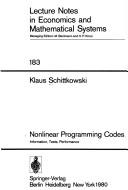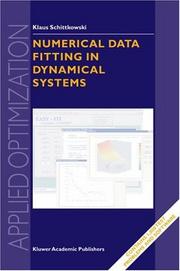| Listing 1 - 10 of 12 | << page >> |
Sort by
|
Book
ISBN: 3540171827 3642615821 9783540171829 Year: 1987 Volume: 282 Publisher: Berlin: Springer,
Abstract | Keywords | Export | Availability | Bookmark
 Loading...
Loading...Choose an application
- Reference Manager
- EndNote
- RefWorks (Direct export to RefWorks)
This collection of 188 nonlinear programming test examples is a supplement of the test problem collection published by Hock and Schittkowski [2]. As in the former case, the intention is to present an extensive set of nonlinear programming problems that were used by other authors in the past to develop, test or compare optimization algorithms. There is no distinction between an "easy" or "difficult" test problem, since any related classification must depend on the underlying algorithm and test design. For instance, a nonlinear least squares problem may be solved easily by a special purpose code within a few iterations, but the same problem can be unsolvable for a general nonlinear programming code due to ill-conditioning. Thus one should consider both collections as a possible offer to choose some suitable problems for a specific test frame. One difference between the new collection and the former one pub lished by Hock and Schittkowski [2], is the attempt to present some more realistic or "real world" problems. Moreover a couple of non linear least squares test problems were collected which can be used e. g. to test data fitting algorithms. The presentation of the test problems is somewhat simplified and numerical solutions are computed only by one nonlinear programming code, the sequential quadratic programming algorithm NLPQL of Schittkowski [3]. But both test problem collections are implemeted in the same way in form of special FORTRAN subroutines, so that the same test programs can be used.

ISBN: 3540102477 0387102477 3642464246 9783540102472 Year: 1980 Volume: 183 Publisher: Berlin: Springer,
Abstract | Keywords | Export | Availability | Bookmark
 Loading...
Loading...Choose an application
- Reference Manager
- EndNote
- RefWorks (Direct export to RefWorks)
Planning (firm) --- Operational research. Game theory --- #TCPW T2.2 --- 519.6 --- 681.3*G16 --- Computational mathematics. Numerical analysis. Computer programming --- Optimization: constrained optimization; gradient methods; integer programming; least squares methods; linear programming; nonlinear programming (Numericalanalysis) --- Business & Economics --- Economic Theory --- 681.3*G16 Optimization: constrained optimization; gradient methods; integer programming; least squares methods; linear programming; nonlinear programming (Numericalanalysis) --- 519.6 Computational mathematics. Numerical analysis. Computer programming --- Algorithms --- Nonlinear programming --- Algorithmes --- Programmation non linéaire

ISBN: 9781402010798 1402010796 1475760507 1441957626 Year: 2002 Volume: 77 Publisher: Dordrecht Boston : Kluwer,
Abstract | Keywords | Export | Availability | Bookmark
 Loading...
Loading...Choose an application
- Reference Manager
- EndNote
- RefWorks (Direct export to RefWorks)
Real life phenomena in engineering, natural, or medical sciences are often described by a mathematical model with the goal to analyze numerically the behaviour of the system. Advantages of mathematical models are their cheap availability, the possibility of studying extreme situations that cannot be handled by experiments, or of simulating real systems during the design phase before constructing a first prototype. Moreover, they serve to verify decisions, to avoid expensive and time consuming experimental tests, to analyze, understand, and explain the behaviour of systems, or to optimize design and production. As soon as a mathematical model contains differential dependencies from an additional parameter, typically the time, we call it a dynamical model. There are two key questions always arising in a practical environment: 1 Is the mathematical model correct? 2 How can I quantify model parameters that cannot be measured directly? In principle, both questions are easily answered as soon as some experimental data are available. The idea is to compare measured data with predicted model function values and to minimize the differences over the whole parameter space. We have to reject a model if we are unable to find a reasonably accurate fit. To summarize, parameter estimation or data fitting, respectively, is extremely important in all practical situations, where a mathematical model and corresponding experimental data are available to describe the behaviour of a dynamical system.
System design --- Mathematical models --- Differentiable dynamical systems --- Parameter estimation --- Systèmes, Conception de --- Modèles mathématiques --- Dynamique différentiable --- Estimation d'un paramètre --- Systèmes, Conception de --- Modèles mathématiques --- Dynamique différentiable --- Estimation d'un paramètre --- Systèmes dynamiques. --- Analyse numérique. --- Differentiable dynamical systems. --- Numerical analysis. --- Differential equations --- Initial value problems --- Équations différentielles --- Problèmes aux valeurs initiales --- Mathematical optimization. --- Mathematical models. --- Applied mathematics. --- Engineering mathematics. --- Statistics . --- Numeric Computing. --- Optimization. --- Mathematical Modeling and Industrial Mathematics. --- Applications of Mathematics. --- Statistics for Life Sciences, Medicine, Health Sciences. --- Statistical analysis --- Statistical data --- Statistical methods --- Statistical science --- Mathematics --- Econometrics --- Engineering --- Engineering analysis --- Mathematical analysis --- Models, Mathematical --- Simulation methods --- Optimization (Mathematics) --- Optimization techniques --- Optimization theory --- Systems optimization --- Maxima and minima --- Operations research --- System analysis --- Systèmes dynamiques --- Analyse numérique --- Differential equations. --- Initial value problems. --- Équations différentielles. --- Problèmes aux valeurs initiales --- Moindres carres --- Programmation mathematique --- Programmation non lineaire
Dissertation
Year: 1975 Publisher: Würzburg s.n.
Abstract | Keywords | Export | Availability | Bookmark
 Loading...
Loading...Choose an application
- Reference Manager
- EndNote
- RefWorks (Direct export to RefWorks)
Book
Year: 1980 Publisher: Berlin, Heidelberg, New York Springer
Abstract | Keywords | Export | Availability | Bookmark
 Loading...
Loading...Choose an application
- Reference Manager
- EndNote
- RefWorks (Direct export to RefWorks)
Book
Year: 1985
Abstract | Keywords | Export | Availability | Bookmark
 Loading...
Loading...Choose an application
- Reference Manager
- EndNote
- RefWorks (Direct export to RefWorks)
Book
ISBN: 3540105611 3642483208 Year: 1981 Publisher: Berlin Springer
Abstract | Keywords | Export | Availability | Bookmark
 Loading...
Loading...Choose an application
- Reference Manager
- EndNote
- RefWorks (Direct export to RefWorks)
................................................................. The performance of a nonlinear programming algorithm can only be ascertained by numerical experiments requiring the collection and implementation of test examples in dependence upon the desired performance criterium. This book should be considered as an assis tance for a test designer since it presents an extensive collec tion of nonlinear programming problems which have been used in the past to test or compare optimization programs. He will be in formed about the optimal solution, about the structure of the problem in the neighbourhood of the solution, and, in addition, about the usage of the corresp,onding FORTRAN subroutines if he is interested in obtaining them -ofi a magnetic tape. Chapter I shows how the test examples are documented. In par ticular, the evaluation of computable information about the solu tion of a problem is outlined. It is explained how the optimal solution, the optimal Lagrange-multipliers, and the condition number of the projected Hessian of the Lagrangian are obtained. Furthermore, a classification number is defined allowing a formal description of a test problem, and the documentation scheme is described which is used in Chapter IV to present the problems.
Planning (firm) --- Operational research. Game theory --- 519.85 --- 517.988 --- 681.3*G16 --- Mathematical programming --- Nonlinear functional analysis and approximation methods --- Optimization: constrained optimization; gradient methods; integer programming; least squares methods; linear programming; nonlinear programming (Numericalanalysis) --- Management --- Business & Economics --- Management Theory --- 681.3*G16 Optimization: constrained optimization; gradient methods; integer programming; least squares methods; linear programming; nonlinear programming (Numericalanalysis) --- 517.988 Nonlinear functional analysis and approximation methods --- 519.85 Mathematical programming
Book
ISBN: 0387105611 9780387105611 Year: 1981 Publisher: Berlin: Springer,
Abstract | Keywords | Export | Availability | Bookmark
 Loading...
Loading...Choose an application
- Reference Manager
- EndNote
- RefWorks (Direct export to RefWorks)
Book
Year: 1981 Volume: 187 Publisher: Berlin,Heidelberg : Springer-Verlag,
Abstract | Keywords | Export | Availability | Bookmark
 Loading...
Loading...Choose an application
- Reference Manager
- EndNote
- RefWorks (Direct export to RefWorks)
Book
Year: 1981 Publisher: Berlin, Heidelberg, New York Springer
Abstract | Keywords | Export | Availability | Bookmark
 Loading...
Loading...Choose an application
- Reference Manager
- EndNote
- RefWorks (Direct export to RefWorks)
| Listing 1 - 10 of 12 | << page >> |
Sort by
|

 Search
Search Feedback
Feedback About UniCat
About UniCat  Help
Help News
News